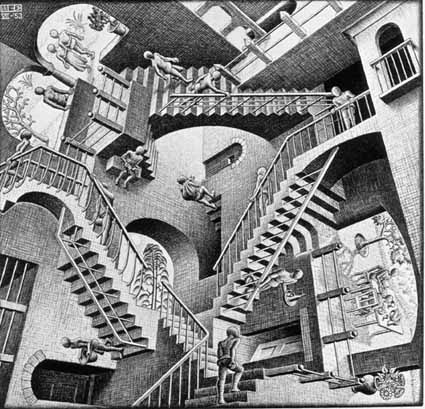
|
|||
10 Paradoxes That Will Totally Surprise You
Source :http://www.oddee.com/item_98777.aspx
A paradox is a statement that apparently contradicts itself and yet might be true. Most logical paradoxes are known to be invalid arguments, but they are still valuable in promoting critical thinking. Read on to discover ten paradoxes that will totally surprise you. The Paradox of Value: Why is water cheaper than diamonds, since humans need water, not diamonds, to survive?  The paradox of value (also known as the diamond–water paradox) is the apparent contradiction that, although water is on the whole more useful in terms of survival, diamonds command a higher price on the market. At low levels of consumption, water has a much higher marginal utility than diamonds and thus is more valuable. People usually consume water at much higher levels than they do diamonds, and thus the marginal utility and price of water are lower than that of diamonds. In explaining the diamond-water paradox, marginalists explain that it is not the total usefulness of diamonds or water that matters, but the usefulness of each unit of water or diamonds. It is true that the total utility of water to people is tremendous because they need it to survive. However, since water is in such large supply in the world, the marginal utility of water is low. In other words, each additional unit of water that becomes available can be applied to less urgent uses as more urgent uses for water are satisfied. Therefore, any particular unit of water loses value as the supply of water increases. On the other hand, diamonds are in much lower supply. They are of such low supply that the usefulness of one diamond is greater than the usefulness of one glass of water, which is in abundant supply. Thus, diamonds are worth more to people. Therefore, those who want diamonds are willing to pay a higher price for one diamond than for one glass of water, and sellers of diamonds ask a price for one diamond that is higher than for one glass of water. (Link) The Grandfather Paradox: What if you travel in time and kill your grandfather before he meets your grandmother? 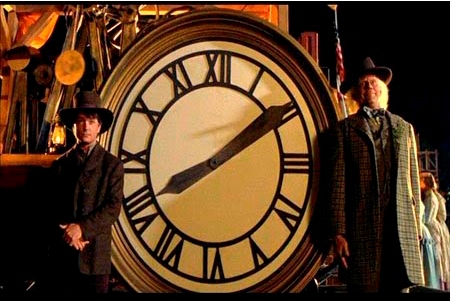 The grandfather paradox is a proposed paradox of time travel that was first described by the science fiction writer René Barjavel in his 1943 book Le Voyageur Imprudent (Future Times Three). The paradox is described as follows: the time traveler went to the past to a moment when his grandfather and grandmother had not married yet. At that time, the traveler kills his grandfather and, therefore, is never born. If he is never born, then he is unable to travel through time and kill his grandfather, which means that he would be born, and so on. Assuming the causal link between the time traveler’s present and future, the grandfather paradox that disrupts that link may be regarded as impossible (thus precluding the arbitrary alteration of one’s fate). However, a number of hypotheses have been postulated to avoid the paradox, such as the idea that the past is unchangeable, so the grandfather must have already survived the attempted killing (as stated earlier); or the time traveler creates—or joins—an alternate timeline or parallel universe in which the traveler was never born. A variant of the grandfather paradox is the Hitler paradox, or Hitler’s murder paradox, a fairly frequent trope in science fiction in which the protagonist travels back in time to murder Adolf Hitler before he can instigate World War II. Rather than necessarily preventing time travel, the action removes any reason for the travel, along with any knowledge that the reason ever existed, thus removing any point in travelling in time in the first place.(Link)
INITIATING DEBT Joseph Stiglitz, former chief economist for the WB, has commented that a ten percent commission for a corrupt politician (such as a finance minister) in a hidden bank account can readily result in a huge debt imposed upon the citizenry beyond their ability to pay. A private debt then becomes a public obligation. A typical project will raise funds to build a huge electrical power plant or some other large capital investment. The financiers sell bonds backed by the government. The loan requires construction be performed by firms chosen by the lenders. The electrical power will be used to process the nearby aluminum mining owned by the lenders. After construction is finished, the export of ingots to the U.S. is determined to be unprofitable and is discontinued. The nation loses the revenue of the mining but must still pay for the construction bonds, which results in national financial chaos and austerity. Iceland, as a different methodology, was fleeced by foreign bankers that corrupted the CEOs of Iceland’s three banks. 7 The common thread is that monumental taxes are imposed to pay a pseudo-government debt arranged by a foreign financier which crushes the nation . Chossudovsky documented numerous third world nations impoverished by the IMF through currency devaluation. The European Common Bank (ECB) is restricted in its issuance of Euros by a requirement to obtain authorization from member states. This controls the issuance of fiat money. (An alternate fiat currency by the IMF could be SDRs.) If the European nations give the ECB authority for unrestricted printing of the Euro (to save Europe from financial disaster, of course) it will affect each and every nation of the Common Market. It will allow stealing the wealth of each member nation by the printing press just as interest bearing Federal Reserve Notes replaced U.S. Notes in the United States during 1913 to 1933. It will put all of Europe under perpetual inescapable debt. [QUESTION: Is the Euro issued with the same fraudulent hidden profit scheme the Federal Reserve uses for Federal Reserve Notes? See footnote 33. The Rothschilds have used this scam for centuries.] The Council on Foreign Relations (CFR, created by David Rockefeller) is a social façade of businesses and organizations to multiply gains and eliminate competition. The organization’s secret agenda is to promote a “New World Order” that would be led by the financial elite; it is touted as the utopian society. /8 The interlocking Board of Directors of major businesses which allows control by Wall Street involving Rockefeller trusts and foundations has been known for decades. /9 Recent research concludes sixty percent of global revenue is through Transnational Corporations controlled by financial interests on Wall Street. One percent of corporations control more than 40 percent of world trade. 10 Such concentration is identified to cause economic instability. /11 The common ownership of commercial enterprises with government coercive power to eliminate competition does not appear to be in the best interest of the people. The relationship between international financial institutes is not completely harmonious despite the close affiliation. Stories circulate that Dominique Strauss-Kahn was promoting a new world reserve currency to replace the U.S. Dollar. A visit to New York City is alleged to have led to incarceration and trumped up criminal charges. Charges were dropped after he resigned as head of the IMF. /12 Several years ago the BIS announced it was going to audit the Federal Reserve. It is not known to have occurred. The Wall Street Journal informs us the IMF is projecting tax increases in a considerable number of “advanced” nations such as the U.S., Europe, and Japan. The story relates it will be a “significant” tax on the wealthy. We all know how that goes. Does David Rockefeller pay any personal taxes? Tim Geithner only pays taxes when he wants congressional approval for a government appointment. The IMF is telling us the middle class is going to get reamed (the IMF says the U.S. has way too low of a tax rate) just like what has been done in the under-developed nations. The future U.S. society will consist of the abject poor and the elite—no middle class. 13 ENTER THE ENFORCERS It would be a mistake to blame greedy politicians for all of the rapacious debts. John Perkins informs us that if the financier’s offer of a loan is refused, the CIA “jackals” are called in for a “wet operation” (murder). /14 It is assumed similar pressure may be put on nations to coerce membership in the WB and IMF. Colonel Gaddafi refused to join and paid the price. The CIA’s School of the Americans (now WHINSEC) brings foreign military leaders to the U.S. for training. The sessions include recruiting CIA assets along with teaching torture and suppression of protests against their local government. It also permits screening and recruitment of future puppet leaders for nations that require a coup if a ruler becomes reluctant to pay a debt. Al Queda was created by the CIA in the 1980’s (with Osama ben Laden as the leader to drive the USSR out of Afghanistan. When Osama wanted the U.S. out of Afghanistan, he had to go.) and is now spun as the cause for endless violence, terrorism and martial law. /15 The Paradox of Saving: If everyone tries to save during a recession, aggregate demand will fall and the population’s total savings will be lower.  The Paradox of Saving: If everyone tries to save during a recession, aggregate demand will fall and the population's total savings will be lower. The paradox thrift, or paradox of saving, states that if everyone tries to save more money during times of economic recession, then aggregate demand will fall and will, in turn, lower total savings in the population because of the decrease in consumption and economic growth. The paradox is, narrowly speaking, that total savings may fall even when individual savings attempt to rise, and, broadly speaking, that increase in savings may be harmful to an economy because while individual thrift is generally averred to be good for the economy, the paradox of thrift holds that collective thrift may be bad for the economy. Hypothetically, if all people will save their money, savings will rise, but there is a tendency that the macroeconomic status will fall.
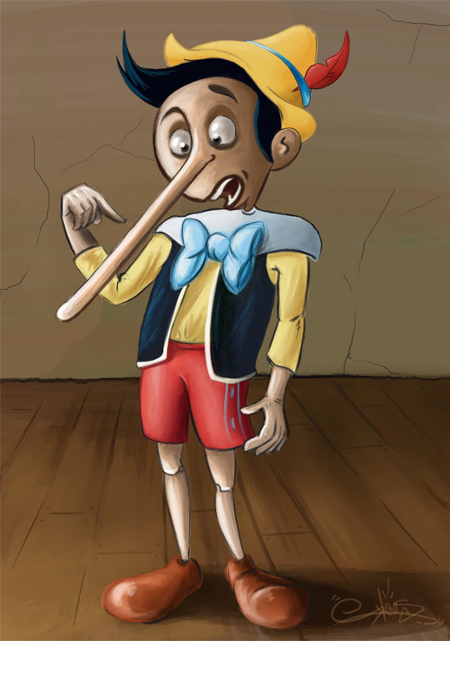 The Pinocchio paradox arises when Pinocchio says, “My nose grows now,” and it is a version of the liar paradox. The liar paradox is defined in philosophy and logic as the statement “This sentence is false.” Any attempts to assign a classical binary truth value to this statement leads to a contradiction, or paradox. This occurs because if the statement “This sentence is false” is true, then it is false; this would mean that it is technically true, but also that it is false, and so on without end. Although the Pinocchio paradox belongs to the liar paradox tradition, it is a special case because it has no semantic predicates, as “My sentence is false” does, for example. The Pinocchio paradox has nothing to do with Pinocchio being a known liar. If Pinocchio were to say, “I am getting sick,” this could be either true or false, but Pinocchio’s sentence “My nose grows now” can be neither true nor false; hence this and only this sentence creates the Pinocchio (liar) paradox. (Link) The Barber’s Paradox: In a village where the barber shaves everyone who does not shave himself, who shaves the barber?  Suppose you walk past a barber’s shop one day and see a sign that reads, “Do you shave yourself? If not, come in and I’ll shave you! I shave anyone who does not shave himself, and no one else.” This seems fair enough, and fairly simple, until the following question occurs to you – does the barber shave himself? If he does, then he mustn’t, because he doesn’t shave men who shave themselves, but then he doesn’t, so he must, because he shaves every man who doesn’t shave himself… and so on. Both possibilities lead to a contradiction. This is the Barber’s Paradox, which was introduced by the British mathematician, philosopher, and conscientious objector Bertrand Russell at the beginning of the twentieth century. It exposed a huge problem which changed the entire direction of twentieth century mathematics. In the Barber’s Paradox, the condition is “shaves himself,” but the set of all men who shave themselves can’t be constructed, even though the condition seems straightforward enough, because we can’t decide whether the barber should be in or out of the set. Both conditions lead to contradictions. Attempts to find ways around the paradox have centered on restricting the types of sets that are allowed. Russell himself proposed a “Theory of Types” in which sentences were arranged hierarchically. At the lowest level are sentences about individuals. At the next level are sentences about sets of individuals; at the next level are sentences about sets of individuals, and so on. This avoids the possibility of having to talk about the set of all sets that are not members of themselves, because the two parts of the sentence are of different types – that is, at different levels. For this and other reasons, the most favored escape from Russell’s Paradox is the so-called Zermelo-Fraenkel axiomatisation of set theory. This axiomatisation restricts the assumption of naïve set theory, which states that, given a condition, you can always make a set by collecting exactly the objects satisfying the condition. Instead, you start with individual entities, make sets out of them, and work upwards. This means that you do not have to suppose that there is a set of all sets, which means you don’t have to try to divide that set up into those sets that contain themselves and those which don’t. You only have to be able to make this division for the elements of any given set, which you have built up from individual entities via some number of steps. A possible (sexist) solution: Just make the barber a woman. (Link) Birthday Paradox: How can such a small group have two people with the same birthday?  The Paradox of the Chicken or the Egg: Which came first, the chicken or the egg? 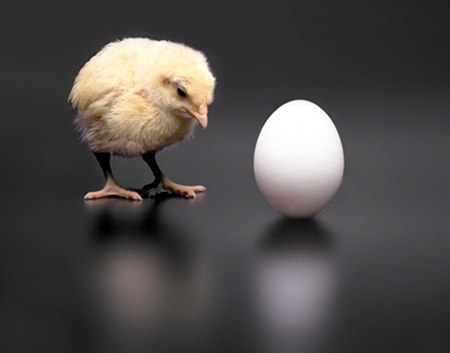 The chicken or the egg causality dilemma is commonly stated as “which came first, the chicken or the egg?” To ancient philosophers, the question about the first chicken or egg also evoked the questions of how life and the universe in general began. Cultural references to the Chicken and Egg intend to point out the futility of identifying the first case of a circular cause and consequence. It could be considered that in this approach lies the most fundamental nature of the question. A literal answer is somewhat obvious to some people, as egg-laying species pre-date the existence of chickens. To others, the chicken came first, seeing as chickens are merely domesticated Red Junglefowls. However, the metaphorical view sets a metaphysical ground to the dilemma. To better understand its metaphorical meaning, the question could be reformulated as: “Which came first, X that can’t come without Y, or Y that can’t come without X?” When the Earth was created many years ago, the chicken was created. Then it laid an egg. If the egg came first, and it hatched, who was there to warm it, and who was there to feed it when it was a little chick? (Link) The Paradox of the Missing Square Puzzle: Why does a square appear for no reason? 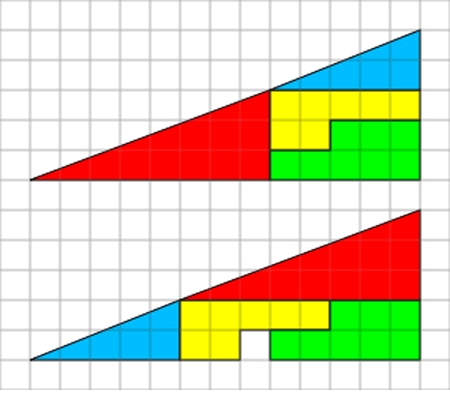 The key to the puzzle is the fact that neither of the “triangles” is truly a triangle, because what appears to be the hypotenuse is bent. In other words, the “hypotenuse” does not maintain a consistent slope, even though it may appear that way to the human eye. So, with the bent hypotenuse the first figure actually occupies a combined 32 units, while the second figure occupies 33, including the “missing” square. Note the grid point where the red and blue triangles in the lower image meet (5 squares to the right and two units up from the lower left corner of the combined figure), and compare it to the same point on the other figure; the edge is slightly under the mark in the upper image, but goes through it in the lower. Overlaying the hypotenuses from both figures results in a very thin parallelogram with an area of exactly one grid square—the same area “missing” from the second figure. LINK Submit News/Videos/Links | Discuss article | Article Link | More Unsolved and Unexplained Mysteries |
More can be addded on request. Direct your requests at vinit@theunexplainedmysteries.com
